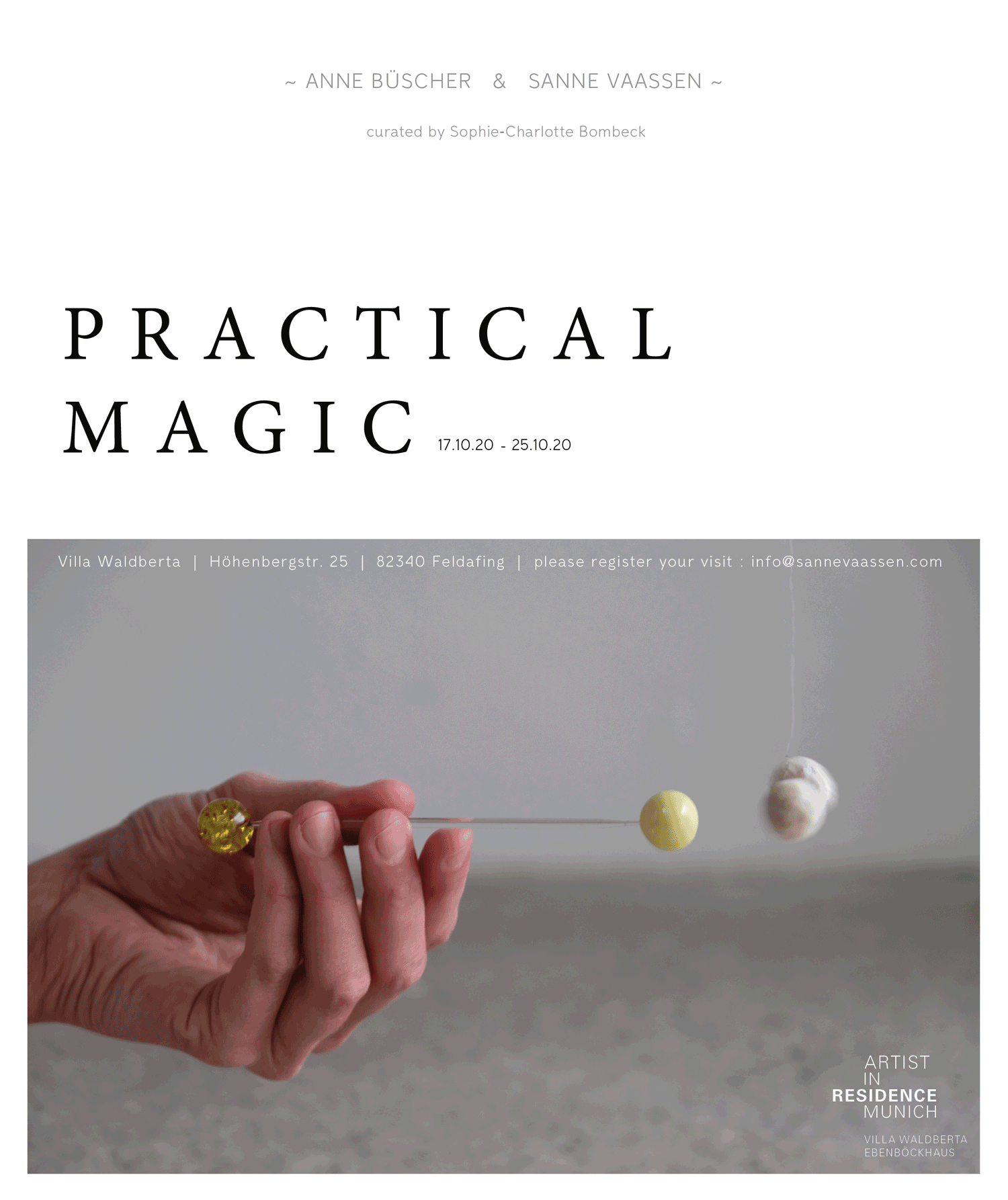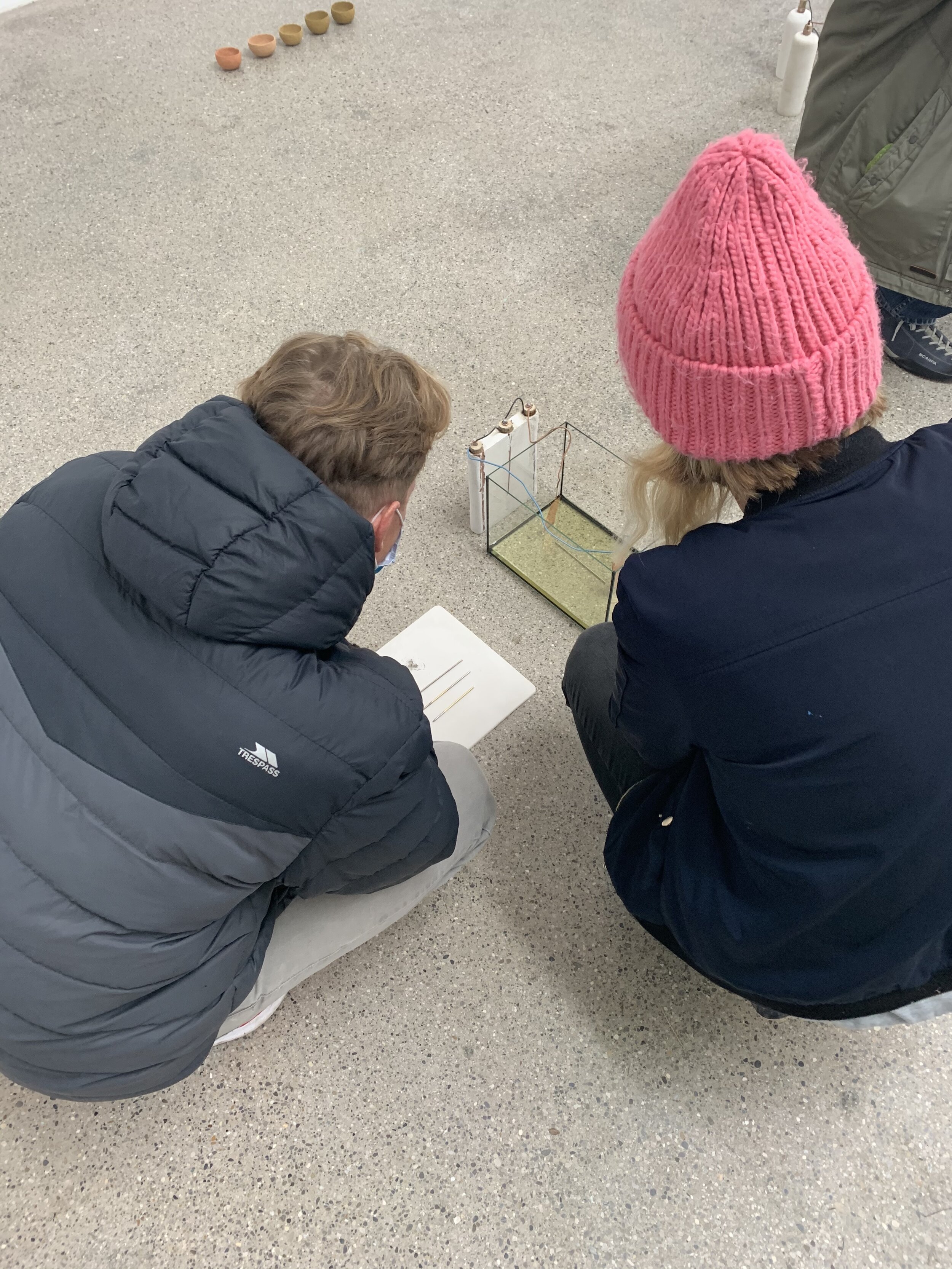PRACTICAL MAGIC @ VILLA WALDBERTA
Anne Büscher & Sanne Vaassen
curated by Sophie-Charlotte Bombeck
OPENING SA. 17/10/2020 3 - 7 pm EXHIBITION 18/10/ bis 25/10/2020
VISIT ONLY BY APPOINTMENT VIA info@sannevaassen.com
The exhibition Practical Magic presents works by guest artists Anne Büscher & Sanne Vaassen from Maastricht in the Palm House of Villa Waldberta. The exhibited works are results, interim results and documentations that were created during the residency period and on which the artists will work until the end of their stay. The artists' studios will also remain visible to visitors from the outside for the duration of the exhibition, allowing them to experience the work and approaches of both artists. For both artists the contact to nature is crucial. They act directly on the surroundings of Villa Waldberta and work with the phenomena and materials they encounter during their stay. It is a kind of artistic research which, contrary to the rationality of science, provides the viewer with a different approach to it on a higher level of abstraction with its numbers, data and facts. By investigating, analysing and documenting natural phenomena from an artistic perspective, new approaches and perspectives are thus created.
In the exhibition, Anne Büscher deals with the physical properties of electricity in its natural form. To use energy as a material - means in this case to demand its own laws from electricity and to find an adequate form for its essence; from which new possibilities and new paths are constantly being derived. Electricity is a medium that is not visible on its own, but constantly surrounds us. It is universal, but is usually not perceived as material. The name electricity was taken from the Greek word for amber electron. As early in antiquity, it was discovered that amber, when rubbed against it (e.g. with a piece of leather), would exert a force on the body.
In a series of experimental set-ups the artist approaches the phenomenon, which has its cause in resting or moving electric charge. With the help of simple physical laws, the artist thus creates a trans-disciplinary connection between artistic and scientific research, with specially developed model constructions made of various materials such as glass, plaster, water, tourmaline, elderberry, sulphur and amber. The installation series Demonstration devices for natural electricity, variable dimensions, 2020 thus explores its material side through various natural materials. In the experimental set-ups, Anne Büscher demonstrates phenomena that have their origin in static or moving electric charges. Each artistic experimental model or arrangement is developed by her to understand the origin of electricity and explore its properties and characteristics. The visitors* thus encounter various setups in the exhibition. One of these is the work The electric Kiss: inspired by an 18th century experiment in which electric charge was transferred to another body through a kiss.
A further experimental set-up was inspired by the discovery of the so-called Baghdad battery. The battery is a clay vessel found in 1936 during an excavation near Baghdad and may have already served as a battery in ancient Egypt for 2000 years. The reproduction of the battery can be seen in clay in the artist's studio. The exhibition includes plaster cylinders which generate electricity and with which the artist will make various experiments during the exhibition, including a galvanic bath (a glass basin which allows silver pins to grow) and the powering of a fan.
The work Moon light print revolves around the tactile aspects of photography, in which the outcome is not determined by a camera, but by the exposure of silver gelatine paper to natural moonlight. During this residency Anne Büscher often watched the moonrise from the tower of Villa Waldberta. This ritual lead to the idea to make photograms about the moon phases by capturing its intensity in different nights on light-sensitive photo paper. On closer inspection the moon and the methods of photography have more in common than it appears at first glance: the element silver, assigned to the moon by alchemists is by far the most important starting material for the production of light-sensitive materials. After developing the paper its silver ions stay in the used fixing solutions. Likewise to the cycle of the moon the silver first disappears and then grows back into a new object: In this installation Anne Büscher used a galvanic process to grow a silver point pencil with it. Silverpoint is a traditional drawing technique first used by medieval scribes on manuscripts.
Sanne Vaassen presents an impressive collection of preserved plants from the garden of Villa Waldberta. The works presented in the exhibition are based on the Secret Language of Flowers, a tradition that was common in the Victorian era for sending secret messages. Today, the language of flowers has been somewhat forgotten, but flowers and plants were once the code for what one wanted to say or ask but did not dare to say. Flower dictionaries were used to express feelings and convey messages without using written or verbal language.
In the work Tussie Mussie, the artist presents the archived plants from the garden, they are spread across the room and can be admired on the wall, on the floor and in the specially designed archive cabinet. As a place of contemplation, as an archive, Sanne Vaassen creates a book of the flowers of the garden in which the meanings of the individual plants and flowers are transcribed and translated. The peculiar messages are also revealed to the visitor* when he takes a closer look at the archive cabinet, which contains the collected flora of the garden, dried and stored between glass plates. The artist has carefully carved by hand the peculiar phrases and words as for example I am devoted to you, Practical Magic or Beauty is your only attraction by scratching them into the wood.
The communication system of the flowers confronts us in another form. The artist thus creates three perfumes based on three different speeches by Angela Merkel (Chancellor of the Federal Republic of Germany), Hassan Diab (the recently retired Prime Minister of Lebanon) and Narendra Modi (acting Prime Minister of India). A perfume in the strict sense is a fragrance composition that serves the personal well-being of a person and its presentation to others. The use of aromatic substances was considered a source of inspiration and was already used in the ancient advanced civilizations of Egypt and India in the use of handicraft tradition, spirituality and medicine. They were understood as an expression of the aesthetic beauty ideals of their time. Thus the artist uses the speeches of the individual speakers as a kind of recipe and transcribes the words, depending on their frequency, into an instruction for the fragrance compositions. In this way the visitors get an olfactory impression of the individual speakers and their words.
Verbloemen/Nosegay by Sanne Vaassen uses dictionaries of the "Secret Language of Flowers" to reinterpret the speeches of contemporary politicians by starting from the words and then translating them into the equivalent of plants. Each word used in the speech is thus transmitted to a plant and then translated into an essence, which finally forms a fragrance. The scent of the German Chancellor Angela Merkel is based on the speech on corona spreading in the Tagesschau on 18.03.2020. Hassan Diab's scent is a transcription of his speech of 10.08.2020 in which the Lebanese Prime Minister announces the resignation of the government after the explosion in Beirut. The third perfume is a transcription of the speech of Prime Minister Narendra Modi who speaks to the Indian troops in Ladakh on 03/07/202020. Ladakh is the disputed Himalayan region in which China and India have been fighting for supremacy in Central Asia and its borders since 1962.
Please register with your name, contact (e-mail or telephone number) and the day of your planned visit (weekend). Times for desired viewing appointments are to be arranged separately at info@sannevaassen.com.
Please pay attention to the current general orders and official directives concerning Covid 19 and respect the rules and hygiene measures of the exhibition.
OPENING HOURS
Time by appointment only
Palmenhaus
Internationales Künstlerhaus
Villa Waldberta
Höhenbergstr. 25
82340 Feldafing









